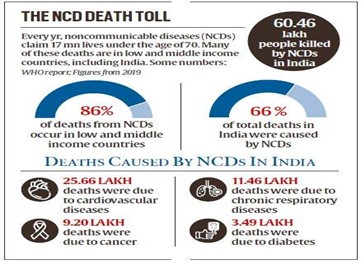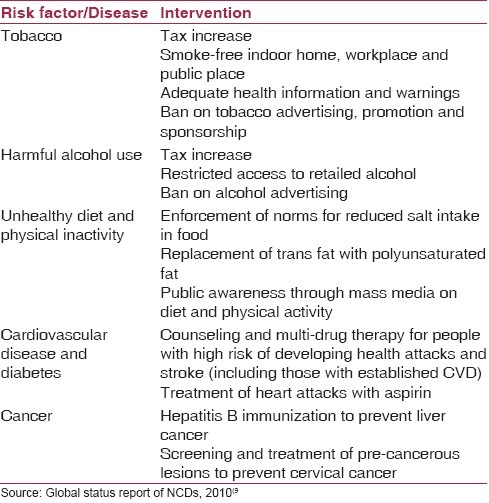- Courses
- GS Full Course 1 Year
- GS Full Course 2 Year
- GS Full Course 3 Year
- GS Full Course Till Selection
- MEP (Mains Enrichment Programme) Data, Facts
- Essay Target – 150+ Marks
- Online Program
- GS Recorded Course
- NCERT- First Ladder
- Polity
- Geography
- Economy
- Ancient, Medieval and Art & Culture AMAC
- Modern India, Post Independence & World History
- Environment
- Governance
- Science & Technology
- International Relations and Internal Security
- Disaster Management
- Ethics
- Current Affairs
- Indian Society and Social Issue
- CSAT
- 5 LAYERED ARJUNA Mentorship
- Public Administration Optional
- ABOUT US
- OUR TOPPERS
- TEST SERIES
- FREE STUDY MATERIAL
- VIDEOS
- CONTACT US
Government Program for NCD Renamed
Government Program for NCD Renamed


Latest Context
The National Program for Prevention & Control of Non-Communicable Diseases (NP-NCD) has become the new name of the existing National Program for Prevention and Control of Cancer, Diabetes, Cardiovascular Diseases and Stroke (NPCDCS). The reason to rename is to subsume all types of Non-Communicable Diseases (NCDs). Furthermore, the Ministry of Health and Family Welfare has renamed the Comprehensive Primary Healthcare Non-Communicable Disease (CPHC NCD IT) system as the National NCD Portal to cover a wider population for screening and management of non-communicable diseases.
NPCDCS/NP-NCD
- Concept: This program was launched in 2010. It is being implemented under the National Health Mission (NHM) across the country.
- Aim: Its objective is to strengthen infrastructure, human resource development, health promotion, early diagnosis, management and referral.
- Management: Under it, NCD Cells are being established at the National, State and District level for its effective management. NCD Clinics are being set up at District and Community Health Centres (CHC) level, to offer services for early diagnosis, treatment and follow-up for common NCDs.
- Achievement: Under this program, 677 NCD district-level clinics, 187 District Cardiac Care Units, 266 District Day Care Centers and 5,392 NCD Community Health Centre-level clinics have been set up.
National Health Mission
Conceptual Framework: The Government of India launched this program in 2013 to include the National Rural Health Mission and the National Urban Health Mission. It comprises programs like Health System Strengthening in rural and urban areas for Reproductive-Maternal-Neonatal-Child and Adolescent Health (RMNCH+A), and Communicable and Non-Communicable Diseases. The objective of NHM is to achieve universal access to equitable, affordable & quality healthcare services which are accountable and responsive to people's needs. The objective of this program is to ensure the achievement of the following indicators:
- Reduce Maternal Mortality Rate (MMR) to 1/1000 live births
- Reduce Infant Mortality rate (IMR) to 25/1000 live births
- Reduce Total Fertility Rate (TFR) to 2.1
- Prevention and reduction of anaemia in women aged 15–49 years
- Prevent and reduce mortality & morbidity from communicable, non- communicable; injuries and emerging diseases
- Reduce household out-of-pocket expenditure on total health care expenditure
- Reduce annual incidence and mortality from Tuberculosis by half
- Reduce the prevalence of Leprosy to <1/10000 population and incidence to zero in all districts
- Annual Malaria Incidence to be <1/1000
- Less than 1 per cent microfilaria prevalence in all districts
- Kala-azar Elimination by 2015, <1 case per 10000 population in all blocks
Non-Communicable Diseases
- Conceptual Framework: These diseases, also known as chronic diseases, are of longer duration and are the result of a combination of genetic, physiological, environmental and behavioral factors. Its types are cardiovascular diseases (such as heart attacks and stroke), cancers, chronic respiratory diseases (such as chronic obstructive pulmonary disease and asthma) and diabetes.
- Causes: Use of Tobacco, harmful use of alcohol, unhealthy diet, physical inactivity, and air pollution are the main risk factors that cause these diseases.

Indian Initiatives
- State Cancer Institutes (SCI): The Central Government is implementing the Strengthening of Tertiary Care Cancer Facilities scheme to support the setting up of State Cancer Institutes (SCI) and Tertiary Care Centers (TCCC) in different parts of the country.
- Affordable Medicines and Reliable Implants for Treatment (AMRIT) Deendayal outlets: These outlets have been opened at 159 Institutions/Hospitals. Their objective is to make available Cancer and Cardiovascular Diseases drugs and implants at discounted prices to patients.
- Jan Aushadhi Stores: These stores are set up by the Department of Pharmaceuticals to provide generic medicines at affordable prices.
- Oncology: It has become a focus in its various aspects of new AIIMS and many upgraded institutions under Pradhan Mantri Swasthya Suraksha Yojana (PMSSY).
Global Level Initiative
- Global Action Plan: In 2019, the World Health Assembly extended the WHO Global action plan for the prevention and control of NCDs from 2013–2020 to 2030. It is also aimed at the development of an Implementation Roadmap from 2023 to 2030 to accelerate progress on preventing and controlling NCDs. In addition, it supports the actions to achieve a set of nine global targets with the greatest impact towards the prevention and management of NCDs.
- Agenda for Sustainable Development: As per the 2030 Agenda for Sustainable Development, heads of state and government are committed to developing ambitious national responses, by 2030 to reduce by one-third premature mortality from NCDs through prevention and treatment (SDG target 3.4). In its ambitious goal. WHO plays a key leadership role in the coordination and promotion of the global fight against NCDs.



